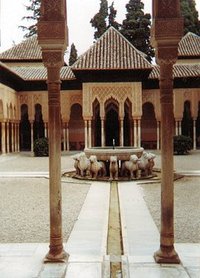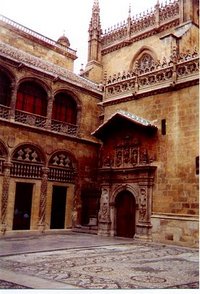Granada
|
|
This page describes the city of Granada in Spain.
- For other uses, see Granada (disambiguation).
| Contents |
The City of Granada
Granada is a city and the capital of the province of Granada, in the community of Andalucía, Spain. It is situated at the foot of the Sierra Nevada mountains, at the confluence of two rivers, Darro and Genil, at an elevation of 738 metres above sea level. At the 2003 census, the population of the city of Granada proper was 237,663, and the population of the entire urban area was estimated to be 450,439, ranking as the 13th-largest urban area of the Spanish Kingdom. About 3.3% of the population did not hold Spanish citizenship, the largest number of these (31%) coming from South America.
The Alhambra, a famous Moorish citadel and palace, is in Granada. It is the most remarkable item of the Muslim, Jewish, and Christian historical legacy that makes Granada a hot spot among cultural and tourist cities in Spain.
Granada is also well-known within Spain due to its prestigious university (http://www.ugr.es/) and, nowadays, wild night-life (though in the 1920s Lorca described the grenadinos as "the worst bourgeoisie in Spain"). In fact, it is said that it is one of the three best cities for college students (the other two are Salamanca and Santiago de Compostela).
The pomegranate (in Spanish, granada) is the heraldic device of Granada.
The beauty of the sights of Granada is famous. A well known verse says:
| « Dale limosna, mujer que no hay en la vida nada como la pena de ser ciego en Granada » | "Give him some money, woman because there is nothing like the pity of being blind in Granada" |
| — Francisco de Icaza | |
History of Granada
Pre-Nasrid
The city has been inhabited from the dawn of history. There was an Ibero-Celtic settlement here, which made contact in turn with Phoenecians, Carthagenians and Greeks. By the 5th century BCE, the Greeks had established a colony which they named "Elybirge". Under Roman rule, in the early centuries CE, this name had become "Ilíberis". The Visigoths maintained the importance of the city as a centre of both ecclesiastical and civil administration and also established it as a military stronghold.
A Jewish community established itself in what was effectively a suburb of the city, called "Gárnata" or "Gárnata al-yahud" (Granada of the Jews). It was with the help of this community that Moorish forces under Tariq first took the city in 711, though it was not fully secured until 713. They gave it the name "Ilbira", the remaining Christian community calling this "Elvira", and it became the capital of a province of the Caliphate of Cordoba. Civil conflicts that wracked the Caliphate in the early 11th century led to the destruction of the city in 1010. In the subsequent reconstruction, the suburb of Gárnata was incorporated in the city, and the modern name in fact derives from this. With the arrival of the Zirid dynasty in 1013, Granada became an independent kingdom. By the end of the 11th century, the city had spread across the Darro to reach what is now the site of the Alhambra.
Moorish Sultanate and Kingdom of Granada
From 1232 to 1492, Granada (Arabic غرناطة Ġarnāṭah) was the seat of the Nasrid dynasty that ruled the sultanate (until 1238) and kingdom from the mid 13th century to the 15th century, one of the longest-lasting Islamic dynasties in the history of al-Andalus. The Nasrid sultans and kings were responsible for building most of the palaces in the Alhambra.
The city became the seat of the Nasrid kingdom (taifa) in 1238, when the Moors retreated during the Christian reconquest of Spain. The kingdom of Granada linked the commercial routes from Europe to Africa crossing the Sahara. The nation constantly shrunk, and by 1492, it was only a small nation on the southeastern coast. This was the most converted area in the country, in fact, Granada has been described as the first Muslim nation to be completely Muslim - though the description can only have been approximately true, since a Jewish population remained in the city throughout the Moorish era.
The most prominent members of the dynasty are:
- Ibn al-Ahmar (died 1273), the first of the line
- Yusuf I (1334-1354)
- Muhammed V (1354-1391, builder of the royal palace within the Alhambra
- Boabdil, the last of the line, who was defeated and deposed in 1492 by Ferdinand and Isabel
See Nasrid dynasty for a full list of the Nasrid rulers of Granada.
On the 2nd of January 1492, the Moors surrendered to the Spanish, and the kingdom was incorporated into Castile. The fall of Granada holds an important place among the many significant events that mark the latter half of the 15th century. It ended, after an existence of eight hundred years, the Islamic rule in the Iberian Peninsula, and thus formed an offset to the progress of the Muslim power in Eastern Europe and the loss to the Christian world of Constantinople. It advanced Spain to the first rank among the nations of Europe, and gave her arms a prestige that secured for her position, influence, and deference long after the decline of her power had commenced.
Architecture
Albaicin_calle.jpg
There are many important Moorish and Catholic architectural sites in Granada
- The Granada's catheral :
- The Alhambra :
- El Albaicín (Albayzin): The ancient Jewish quarter, containing many original houses from the 16th century
- Calle Calderería: An Albayzin street where you can taste Arab typical food, especially teas and desserts from North Africa
- El Cármen de los mártires: A lovely palace with a beautiful botanic garden near the Alhambra
- Santa Ana Church: 16th century, Mudejar Style
- El Corral del carbón: Deposit of merchandise and shelter of merchants. Adapted after 16th century for theater plays.
- Hospital Real: Funded in 1504 by the Reyes Católicos, now part of the University.
- Santo Domingo Church: Funded in 1512 by the Reyes Católicos.
- San José Church: On the site of the "moans" Almorabitín, the mosque of the morabites, one of oldest in Granada, dating from the 10th century.
- Sacromonte Abbey: Founded in the 17th century. The legend say that the catacombs under the church were the site of the martyrdom of San Cecilio's martyrdom, the city's first bishop and now its patron saint.
- Old University: Now the School of Law, it retains the original 17th century facade.
- Bermejas Towers: Strongpoints on the encircling wall of the Alhambra, they date from the 8th and 9th centuries.
- Basilica San Juan de Dios : Basilica where the rest of this saint rest. Sample of the Granada'sbaroque.
- Elvira's Gate: The principal Gate to the old city Part of the moorish wall.
External links
- Information on the city from the databases of the Andalucian Statistical Institute (http://www.juntadeandalucia.es/institutodeestadistica/sima/htm/sm18087.htm) (in Spanish).
- Alcazaba de La Alhambra (http://www.castillosnet.org/granada/GR-CAS-017.shtml) by castillosnet.org
- Tapas bars in Granada (http://www.mahopa.de/dokumente/e-tapa-bars-in-granada-spain.html)
Template:Commonsca:Ciutat de Granada de:Granada es:Granada (España) eo:Granado (Hispanio) fr:Grenade (Espagne) it:Granada la:Granata nl:Granada (stad) ja:グラナダ pl:Grenada (miasto) ro:Granada fi:Granada




